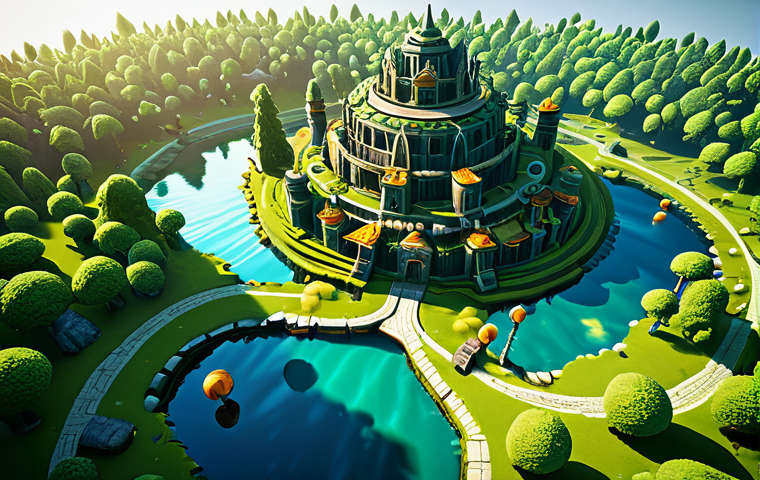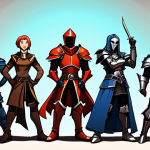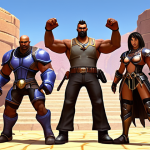Diving into the captivating, time-bending world of Reverse: 1999 can feel like stepping into a beautiful, yet incredibly complex, anachronistic maze. Trust me, I remember that initial rush of excitement mixed with a healthy dose of ‘where do I even start?!’ The character designs are stunning, the story is engrossing, and the combat system is genuinely unique, but for new players, it’s easy to get lost in the sheer volume of currencies, artifacts, and arcane skills.
It’s a common trend we see in many deep gacha RPGs now – an amazing core experience often comes with a steep learning curve that can overwhelm even seasoned gamers, leading to early player drop-off if they don’t find their footing quickly.
You see countless new titles struggling with player retention precisely because of this initial barrier. But what if I told you there are critical foundational steps you can take from day one to avoid those early pitfalls and truly optimize your journey for the long haul?
Forget the feeling of being left behind; I’ve personally navigated those tricky early stages, made my share of blunders, and discovered powerful strategies that I wish someone had told me from the start.
These aren’t just generic tips; they’re distilled from hours of gameplay, community insights, and a deep dive into what truly makes a difference in this game’s demanding meta.
Ready to transform your early game experience from overwhelming to empowering? Let’s figure it out precisely.
Navigating the captivating, time-bending world of Reverse: 1999 can feel like stepping into a beautiful, yet incredibly complex, anachronistic maze. Trust me, I remember that initial rush of excitement mixed with a healthy dose of ‘where do I even start?!’ The character designs are stunning, the story is engrossing, and the combat system is genuinely unique, but for new players, it’s easy to get lost in the sheer volume of currencies, artifacts, and arcane skills.
It’s a common trend we see in many deep gacha RPGs now – an amazing core experience often comes with a steep learning curve that can overwhelm even seasoned gamers, leading to early player drop-off if they don’t find their footing quickly.
You see countless new titles struggling with player retention precisely because of this initial barrier. But what if I told you there are critical foundational steps you can take from day one to avoid those early pitfalls and truly optimize your journey for the long haul?
Forget the feeling of being left behind; I’ve personally navigated those tricky early stages, made my share of blunders, and discovered powerful strategies that I wish someone had told me from the start.
These aren’t just generic tips; they’re distilled from hours of gameplay, community insights, and a deep dive into what truly makes a difference in this game’s demanding meta.
Ready to transform your early game experience from overwhelming to empowering? Let’s figure it out precisely.
Deciphering the Early Game Economy

One of the first things that hit me when I dove into Reverse: 1999 was the sheer number of different currencies and resources flying around. It felt like walking into a foreign exchange market without a guide! Seriously, you’ve got Sharpodonty, Dust, Clear Drops, Unilogs, Wilderness Shells, and then a whole host of materials for Insight, Resonance, and Psychubes. It’s easy to get overwhelmed and just spend things willy-nilly, but I quickly learned that understanding the primary currencies and their optimal early uses is absolutely crucial for sustainable progress. Mismanaging these resources early on can severely bottleneck your character progression, leading to frustration when you can’t level up or upgrade your favorite Arcanists. I’ve seen countless players hit a wall because they weren’t strategic about where their precious Sharpodonty was going, or they blew all their Clear Drops on standard banners instead of saving for rate-ups. It’s a classic gacha game trap, and Reverse: 1999 lays it out beautifully, enticing you to spend before you understand the long-term implications. My advice? Take a deep breath and let’s break down where your initial focus should be.
1. Prioritizing Your Sharpodonty and Dust Spending
Sharpodonty and Dust are your bread and butter, the foundational elements for nearly every character progression system in the game, from leveling up Arcanists to ascending them through Insight. At the beginning, it feels like you’re drowning in these, especially after clearing early story chapters and completing daily missions. But trust me, that feeling is fleeting. Before you know it, you’ll be constantly scrounging for more. My biggest early game mistake was spreading my resources too thin, trying to level up every Arcanist I pulled. Don’t do that! Focus your Sharpodonty and Dust on your core team of 3-4 Arcanists that you plan to take through the main story and early challenging content. Specifically, prioritize getting your damage dealers and primary supports to Insight 1 and then Insight 2 as quickly as possible. The stat boosts from Insight levels are massive, unlocking new abilities and significantly increasing their combat effectiveness. Remember, the game rewards depth over breadth, especially in the early stages where resources are relatively scarce compared to the later game. Farming the resource stages (The Open Road and The Pneuma Analysis) should become a regular part of your routine once your stamina allows it. Don’t underestimate how quickly you’ll burn through thousands, even millions, of these as your roster grows.
2. Maximizing Clear Drop and Unilog Value
Clear Drops are your premium currency, essentially the equivalent of “gems” or “primogems” in other gacha games. Unilogs are your standard summon tickets. It’s tempting to use every single Clear Drop you get on the standard banner, especially when you’re itching for new characters. I know that feeling – the thrill of pulling something new is intoxicating! However, a crucial piece of advice I wish I’d absorbed earlier is to save your Clear Drops for limited-time banners featuring rate-up Arcanists that align with your team’s needs or simply characters you genuinely love. Standard banners are always there, and you’ll accumulate Unilogs over time through events, daily logins, and story progression. The pity system carries over between limited banners, so saving up guarantees you’ll eventually get the featured Arcanist if you pull enough. Also, never spend Clear Drops on stamina refreshes in the early game unless you are genuinely desperate to clear a specific piece of content for a critical reward. Your natural stamina regeneration and the abundance of stamina items from events will usually suffice. Patience is truly a virtue when it comes to the gacha system in Reverse: 1999; impulsive spending often leads to regret.
Building Your Formidable Arcanist Roster
Stepping into the character selection screen in Reverse: 1999 can be a bewildering experience. With a constantly expanding cast of Arcanists, each with unique affiliations, damage types, and skill sets, it’s easy to fall into the trap of thinking you need every single one or that only 6-star characters are worth investing in. I’ve personally made the mistake of chasing after every new Arcanist, only to find my resources spread thin and my main team lacking the power to tackle tougher content. What I quickly discovered, however, is that Reverse: 1999 is surprisingly generous with its lower-rarity characters, many of whom are incredibly viable and, in some cases, even meta-defining when properly invested in. The game emphasizes synergy and thoughtful team composition far more than raw individual power levels, which is a breath of fresh air compared to some other titles that push a “whale or fail” mentality. Building a balanced team early on will save you a lot of headaches later, ensuring you have the right tools to deal with various enemy types and combat scenarios. Don’t let rarity dictate your entire strategy; understand roles and how characters complement each other.
1. The Golden Rule of Team Composition: Roles and Synergy
When you’re first assembling your team, don’t just throw your highest-rarity Arcanists together. That was my initial approach, and it led to some truly frustrating battles where I couldn’t keep my characters alive or deal enough damage. Instead, think about the three core roles: a Main DPS (Damage Per Second), a Support (Healer, Buffer, Debuffer), and a Sub-DPS/Flex slot. Your Main DPS will be responsible for most of your damage output, so characters like Regulus, Eternity, or even the fantastic 5-star characters like Centurion are excellent early investments. For supports, healers like Balloon Party or Medicine Pocket are invaluable for keeping your team topped up. I found myself relying heavily on Balloon Party for a long time due to her consistent healing and damage reduction. The Sub-DPS/Flex slot can be another damage dealer, a control character, or even another healer depending on the specific encounter. Experiment with different elemental types to ensure you have coverage against various enemy weaknesses. Don’t be afraid to invest in 4-star Arcanists like Sonetto or Dikke; they punch well above their weight class and are much easier to obtain and P5 (Portray, or duplicate) for extra power. A well-synergized 5-star team can often outperform a poorly constructed 6-star team.
2. Understanding Arcanist Affiliations and Elemental Advantages
Every Arcanist and enemy in Reverse: 1999 belongs to one of six affiliations: Mineral, Plant, Beast, Star, Spirit, or Intellect. This system is crucial for maximizing your damage and minimizing incoming damage. Here’s a quick rundown of the elemental triangle:
| Affiliation | Strong Against | Weak Against |
|---|---|---|
| Mineral | Beast | Plant |
| Plant | Mineral | Star |
| Beast | Star | Mineral |
| Star | Spirit | Beast |
| Spirit | Plant | Star |
| Intellect | Neutral to All | Neutral to All |
When I was first learning the ropes, I’d often forget to check enemy affiliations, and it cost me dearly in tougher stages. Bringing a Star Arcanist against a Beast enemy, for example, results in a significant damage bonus, while bringing a Plant Arcanist against them would make your life much harder. Intellect Arcanists are unique in that they deal neutral damage to all affiliations and receive neutral damage from all, making them versatile but without the powerful advantage bonuses. Always check the enemy’s affiliation before starting a battle, especially in challenging content like Limbo or higher-difficulty story stages. Having a diverse roster across different affiliations, even if it’s just one strong Arcanist per type, will dramatically improve your ability to clear content efficiently. It’s about being smart, not just strong!
Mastering the Combat
The combat in Reverse: 1999 isn’t your typical turn-based fare. It introduces a unique card-merging and Moxie generation system that adds layers of strategic depth. When I first started playing, I’ll admit I just spammed skills and hoped for the best. It looked cool, but my damage was inconsistent, and I was losing battles I felt I should have won. It took me a while to truly grasp the nuances of merging cards, accumulating Moxie for Ultimates, and understanding the order of operations. Once that click happened, it transformed my gameplay. Suddenly, I wasn’t just reacting to enemy attacks; I was proactively setting up powerful turns, chaining Ultimates, and manipulating the card hand to my advantage. This isn’t a game where you can auto-battle your way through everything and expect stellar results, especially as you progress through the story and unlock more challenging game modes. The key lies in being present in every turn and making informed decisions about your card actions.
1. The Art of Card Merging and Positioning
This is where the real strategy comes into play. You draw a hand of skill cards each turn, and you can move them around within your hand. If two identical skill cards of the same rank are next to each other, they merge into a higher-rank, more powerful version of that skill. For example, two Rank 1 “Incantation I” cards merge into one Rank 2 “Incantation II.” Two Rank 2 cards merge into one Rank 3 “Incantation III.” This merging mechanic is absolutely central to maximizing your damage and utility. My rule of thumb became: always look for merges first. Sometimes it’s better to save a card for an extra turn to get a Rank 2 or Rank 3 skill rather than using a Rank 1 prematurely, especially for powerful single-target attacks or critical healing spells. Also, remember that characters gain Moxie when *their* cards are used, or when their cards merge, *even if they’re not the one using the merged card*. This means you can strategically move a character’s card next to another of theirs, merge it, and gain Moxie, even if you plan to use a different character’s skill that turn. This subtle mechanic can accelerate your Ultimate generation significantly.
2. Ultimate Generation and Moxie Management
Your Arcanists’ Ultimates are their most powerful abilities, often turning the tide of battle. To unleash an Ultimate, an Arcanist needs 5 Moxie points. You gain Moxie by using skills, being attacked (some characters gain Moxie when hit), or by merging your own skill cards. My initial instinct was to just use whatever skills appeared, but I quickly realized that smart Moxie management is paramount. Focus on generating Moxie for your main DPS so they can unleash their Ultimate as frequently as possible. For support characters, their Ultimates might be more situational – a big heal, a damage buff, or a powerful crowd control. Don’t hold onto Ultimates indefinitely, but also don’t use them haphazardly. Look for opportune moments: when an enemy is vulnerable, when you need a burst of healing, or when you can chain Ultimates together for maximum impact. Sometimes, using a lower-rank skill to gain that final Moxie point for an Ultimate is far more valuable than using a high-rank skill that doesn’t push you to an Ultimate. It’s about thinking one or two turns ahead, anticipating both enemy actions and your own card draws.
Optimizing Resonance for Maximum Power
Resonance is arguably one of the most impactful progression systems in Reverse: 1999, yet it’s often the one new players find the most confusing. When I first unlocked it, I stared at that hexagonal grid with a mix of excitement and complete bewilderment. It looked like a complicated puzzle, and frankly, I was too intimidated to mess with it much beyond auto-equipping. Big mistake! Resonance allows you to fine-tune your Arcanists’ stats in incredibly powerful ways, boosting their damage, survivability, and utility far beyond what simple leveling or Insight can achieve alone. It’s essentially Reverse: 1999’s version of an artifact or gear set system, but with a unique spatial puzzle twist. Understanding how to properly configure your Resonance grid, even with limited resources in the early game, will give your core team a massive edge in content that would otherwise feel insurmountable. This is where a little bit of planning and knowledge truly pays off, transforming your characters from good to great.
1. The Basics of Resonance Block Placement
The Resonance grid is a hexagon where you place various-shaped blocks (like Tetris pieces!) that provide different stats. Each block has a shape and gives specific attributes like ATK, HP, DEF, Crit Rate, Crit Damage, Penetration Rate, etc. The goal is to fill as much of the grid as possible with these blocks, activating “Resonance Level” bonuses as you hit certain thresholds (e.g., Level 5, Level 10, Level 15). For your main DPS, your primary focus should always be ATK, Crit Rate, and Crit Damage. For your supports and healers, HP and DEF are crucial, though some supports might also benefit from ATK if their skills scale with it. In the early game, you won’t have a massive selection of high-rarity Resonance materials, so focus on filling the grid efficiently with what you have. Don’t worry about perfect builds yet; simply getting to Resonance Level 5 or 10 will provide a substantial boost. I found that prioritizing those core stats for each Arcanist’s role made a tangible difference in how easily I cleared stages.
2. Advanced Resonance Strategy: Breaking and Synergy
As you progress, you’ll unlock more Resonance blocks and gain access to more advanced strategies. The key here is to look for blocks that not only fit well into the grid but also provide synergistic stats for your Arcanist. For example, a damage dealer who relies heavily on critical hits will want blocks that boost both Crit Rate and Crit Damage. Some blocks have unique shapes that allow them to cover more area or connect more effectively with others. Don’t be afraid to experiment with different arrangements. What worked for me was using an online Resonance calculator or looking up recommended builds for my specific Arcanists. While I advocate for trying things out yourself, for a system as complex as Resonance, leveraging community knowledge can save you a lot of trial and error and wasted resources. Remember, you can always remove and re-place Resonance blocks, so it’s not a permanent commitment. This flexibility means you can adapt your builds as you acquire better materials or as your team composition evolves. It’s a system designed for ongoing optimization, and mastering it truly unlocks your Arcanists’ full potential.
Navigating the Wilderness: Your Personal Island
The Wilderness in Reverse: 1999 initially struck me as a cool but somewhat secondary feature – a sort of base-building mini-game. I figured it was just for aesthetics, something to dabble in when I had nothing else to do. How wrong I was! The Wilderness is actually a crucial, passive income generator that will significantly boost your resource acquisition over time, particularly for Sharpodonty, Dust, and Insight materials. Neglecting your Wilderness development is like leaving free money on the table. It provides a steady stream of vital resources that are otherwise time-gated or stamina-intensive to farm. I quickly realized that dedicating a few minutes each day to managing my island, upgrading facilities, and placing my Arcanists correctly was one of the most efficient uses of my time in the game. It’s a set-and-forget system that continuously works for you in the background, making your overall progression much smoother and less reliant on constant grinding. Don’t sleep on your personal island; it’s more than just a pretty landscape.
1. Prioritizing Facility Upgrades for Resource Generation
When you first gain access to the Wilderness, you’ll have basic structures like the Foundation and the Arcane Farm. Your immediate priority should be upgrading these structures and unlocking new ones that generate resources. Focus heavily on structures that produce Sharpodonty and Dust, as these are your most consistently needed currencies. Later on, prioritize those that produce the materials needed for Insight. The more you upgrade these facilities, the more efficiently they generate resources, and the higher the capacity they’ll have. This means fewer times you’ll need to collect and more passive income. I made it a point to check my Wilderness every time I logged into the game, collecting resources and queuing up the next batch of upgrades. It’s a slow burn, but the cumulative effect over weeks and months is staggering. Don’t just build; strategically upgrade based on your most pressing resource needs. You’ll thank yourself later when you’re not constantly running out of materials for that next Insight level.
2. Strategic Placement of Arcanists and Islands
Beyond upgrading facilities, the placement of your Arcanists and the different “Island” structures plays a subtle but important role. Each Arcanist has a specific talent that boosts certain resource generations when placed in the Wilderness. Some might increase Sharpodonty output, others Dust, and so on. Always assign Arcanists to the resource-generating facilities where their talents provide a bonus. It’s a small optimization, but every little bit helps. Furthermore, as you acquire more “Island” pieces (the large landscape blocks), place them strategically to maximize your “Vitalization” score, which in turn boosts overall resource generation. Some islands have unique effects or synergize with specific Arcanists. I found that experimenting with different layouts, even if just for a few minutes, could noticeably increase my passive income. Don’t just place islands wherever they fit; think about how they interact with each other and how they can best contribute to your resource engine. Your Wilderness isn’t just a pretty place; it’s a vital part of your economic engine.
The Gacha Game Plan: Prudent Pulling and Progression
Let’s be real: at the heart of Reverse: 1999, like any good gacha, is the thrill (and sometimes despair) of pulling for new characters. It’s exhilarating when that golden animation hits and a new 6-star Arcanist graces your roster. But this is also where many new players make their biggest financial and resource mistakes. I’ve personally experienced the sting of pulling on every banner, only to find myself out of Clear Drops when a truly game-changing Arcanist arrived. My initial approach was haphazard; I pulled based on aesthetics or hype without considering my existing roster or long-term goals. This led to a “feast or famine” cycle where I either had too many characters I couldn’t build or none of the ones I truly needed. A disciplined approach to your gacha strategy is not about stifling your enjoyment; it’s about maximizing your chances of getting the Arcanists that will genuinely elevate your gameplay experience and enable you to clear all the content the game throws at you. This foresight will save you countless hours of grinding and potential real-world money.
1. The Power of Selective Summoning and Pity Management
The single most important piece of advice for gacha games is to be selective with your pulls. Don’t pull on every single banner, especially early on. Identify a few key Arcanists that you either really want or that fill a critical gap in your team composition (e.g., a strong DPS if you lack one, or a top-tier healer). Research future banners if possible – a quick search online can often reveal upcoming characters and their kits, allowing you to plan your Clear Drop savings. The pity system in Reverse: 1999 is fairly generous, carrying over between limited banners, which means every pull you make contributes to your next guaranteed 6-star. My strategy evolved to saving at least 70-80 pulls (enough for a soft pity) for a specific Arcanist I really wanted. This way, I always felt confident I’d secure them, even if it meant skipping a few banners in between. It takes discipline, but the payoff of getting that specific character you’ve been eyeing is immense, rather than scattering your resources across multiple banners and potentially getting nothing you truly need.
2. Resource Farming for Insight Materials and Psychubes
Pulling Arcanists is only half the battle; building them is the other, often more challenging, half. As you progress, you’ll find yourself desperately needing specific Insight materials (like Crystallized Dust, Golden Thread, or Mane’s Stride) to ascend your characters to Insight II and III. These materials are heavily gated by stamina and drop rates. Similarly, Psychubes (your version of “weapons” or “artifacts”) are crucial for boosting your Arcanists’ power, and upgrading them requires specific materials and Sharpodonty. My early game frustration often stemmed from having a powerful new Arcanist but no resources to level them up. Prioritize farming these materials daily from the resource stages once you’ve exhausted other immediate priorities. Identify which Arcanists you’ll Insight next and focus your farming efforts on their specific needs. For Psychubes, invest in universal ones that can be swapped between characters (e.g., His Bounden Duty for DPS, That Inquisitive Dear for healers) rather than spreading your limited resources too thin. A well-built 5-star Arcanist with a fully upgraded Psychube and good Resonance will almost always outperform a barely-built 6-star. It’s all about consistent, targeted farming.
Conclusion
Navigating the early game of Reverse: 1999 can feel like a daunting task, but with the right approach, it transforms into an incredibly rewarding experience. I truly believe that by focusing on smart resource management, strategic team building, mastering the unique combat system, and optimizing your Resonance and Wilderness, you’ll not only avoid common pitfalls but also set yourself up for long-term success and enjoyment. Remember, every veteran player started exactly where you are now, feeling a little overwhelmed. The beauty of this game lies in its depth and the satisfaction of watching your Arcanists grow into formidable forces. Take these lessons, apply them consistently, and you’ll soon be clearing content with confidence, ready to tackle whatever challenges the Timekeepers throw your way. Your journey through the Reverse is just beginning, and it’s going to be an epic one!
Handy Tips for Your Journey
1. Don’t underestimate the power of the community! Joining the official Reverse: 1999 Discord server or checking out fan-made wikis and guides can provide invaluable, up-to-date information on character builds, event strategies, and upcoming content. It’s a goldmine of shared knowledge that can save you a lot of trial and error.
2. Consistency is key. Make sure to complete your daily missions and clear weekly Limbo stages as soon as you unlock them. These provide a steady stream of Clear Drops, Unilogs, and crucial progression materials that are vital for maintaining your growth momentum without heavy grinding.
3. While 6-star Arcanists are powerful, don’t ignore the strength of lower-rarity characters. Many 4-star and 5-star Arcanists are incredibly versatile, easy to Portray (get duplicates for), and can be just as, if not more, effective than some 6-stars in the right team composition. Sonetto, Balloon Party, and Dikke are excellent examples of highly viable lower-rarity units.
4. Always keep an eye on upcoming banners. Information about future character releases and their kits is often available online. This allows you to plan your Clear Drop savings strategically, ensuring you have enough pulls for the Arcanists that truly appeal to you or fill a critical gap in your roster.
5. Don’t be afraid to experiment with team compositions and Resonance layouts. The game allows you to reset Resonance for a small fee, and while changing team members might incur a small cost, the insights you gain from trying new synergies are well worth it. Sometimes, an unexpected combination can unlock powerful new strategies.
Key Takeaways
Mastering Reverse: 1999’s early game hinges on strategic resource allocation, prioritizing core team development, and understanding the nuanced combat system. Don’t chase every new character impulsively; instead, save Clear Drops for targeted pulls on limited banners. Consistently upgrade your Wilderness for passive income and diligently farm Insight materials for your main Arcanists. Learning the art of card merging and Moxie management will elevate your combat prowess, while intelligent Resonance builds will significantly boost your characters’ power. Focus on building a balanced team with elemental coverage and remember that strong lower-rarity units can be just as effective as top-tier ones when properly invested in.
Frequently Asked Questions (FAQ) 📖
Q: I just started Reverse: 1999, and honestly, the sheer volume of currencies, artifacts, and arcane skills is making my head spin. Where do I even begin to avoid getting completely overwhelmed and feeling like I’m falling behind?
A: Oh, I totally get that feeling! I remember staring at the screen, feeling like a kid in a candy store that was also a complex math problem. My biggest piece of advice, distilled from my own early blunders, is to focus on building a core team of three characters and sticking with them.
Don’t try to level up every character you get or hoard every single currency initially. Pick one strong DPS (Damage Per Second) character, a good support, and maybe a healer or a second sub-DPS based on who you naturally pull.
Then, pour your early resources – the Dust and Sharpod, especially – into getting those three characters to their first Insight (I1) and then slowly towards I2.
Resist the urge to spread yourself thin. I learned this the hard way, juggling too many characters and ending up with a bunch of mediocre ones instead of three truly powerful ones.
This targeted approach helps you clear early story stages, participate in events, and generally reduces that frantic “where do I even start?!” feeling because you have a clear, actionable goal.
Trust me, it makes a world of difference.
Q: The intro mentioned avoiding early pitfalls and optimizing for the long haul. What’s one common mistake new players make with their resources or character investment that you personally found hinders long-term progress the most?
A: Okay, this is a big one, and honestly, it’s a pitfall I saw many friends, and even myself briefly, tumble into: wasting your Unilogs and Clear Drops on every banner that pops up.
It’s so tempting, isn’t it? That little dopamine hit of pulling a new character is hard to resist. But Reverse: 1999 isn’t a game where you need every character, or even most of them, to succeed.
The biggest long-term progress killer is burning through your limited gacha currency on characters that don’t fit your core strategy or aren’t considered top-tier value units by the community consensus.
I vividly remember impulse-pulling on a banner just because the character looked cool, only to realize later they didn’t synergize with my team at all and those resources would have been far better spent saving for a truly game-changing unit or an Arcanist I really needed for a specific Afflatus type.
Learn from my mistake: research upcoming banners, check character tiers, and be disciplined with your pulls. A strong, well-chosen Rarity 5 or 6 can carry you through so much more content than a dozen scattered, uninvested characters.
Patience, my friend, is your best currency here.
Q: Beyond resource management, what’s a deeper, more tactical foundational step or combat understanding that will truly give me an edge in Reverse: 1999’s ‘demanding meta,’ especially in those tricky later stages?
A: This is where the game really shines, and where I found my ‘aha!’ moment. It’s not just about who you have, but how you manipulate the Incantation system and Moxie generation to your advantage.
Many new players (myself included, initially) just blindly use whatever cards come up. But the true game-changer is learning to merge Incantations by moving them next to each other, escalating their power and often granting bonus effects, and crucially, using those merges to efficiently generate Moxie for your Ultimates.
Every action costs a point, but merging cards doesn’t! So, strategically moving cards to merge before using them effectively gives you “free” card plays that also give Moxie.
It’s like a mini-puzzle every turn. I spent hours grinding, then I watched a veteran player really break down how they prioritize merging specific Incantations for key characters to hit their Ultimates faster, and it completely transformed my combat.
Suddenly, I wasn’t just surviving; I was orchestrating powerful combos. This deep understanding of the combat system, learning to maximize your actions and Ultimates per turn, is the secret sauce that truly sets skilled players apart in Reverse: 1999’s more demanding content.
It’s a foundational skill that pays dividends constantly.
📚 References
Wikipedia Encyclopedia
구글 검색 결과
구글 검색 결과
구글 검색 결과
구글 검색 결과






